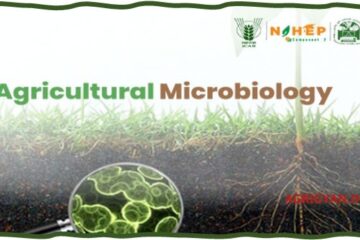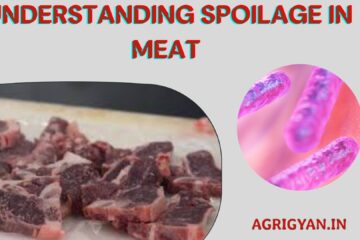Learn about the causes and types of food spoilage in Vegetables and Fruits for FSSAI and food safety officer exams. It covers the primary causes of spoilage in fruits and vegetables, including physical, enzymatic, microbial, and environmental factors.
The article provides detailed information on various types of microbial spoilage, their characteristics, and causative organisms.
Causes of Spoilage
- Physical Factors: This includes mechanical damage from animals, insects, or mishandling. Examples include bruising and cutting, which can create entry points for microorganisms.
- Enzymatic Action: Even after harvest, plant enzymes continue to function, contributing to the spoilage process. Overripe fruits, like a banana with black skin, are a prime example of excessive enzymatic activity.
- Microbial Action: Microorganisms can enter fruits and vegetables through physical damage or deteriorated plant parts and lead to spoilage.
- Environmental Conditions: Improper storage or transport conditions, such as inappropriate temperatures and humidity, can accelerate spoilage.
Types of Microbial Spoilage and their Characteristics
Microbial spoilage manifests in various forms, each with specific characteristics:
- Bacterial Soft Rot: Characterized by a water-soaked appearance, mushy consistency, and foul odor, it’s primarily caused by bacteria like Erwinia carotovora and Pseudomonas marginalis.
- Gray Mold Rot: This type presents as a gray mycelium and thrives in high humidity and warm temperatures. The primary culprit is the fungus Botrytis cinerea.
- Rhizopus Soft Rot: Leading to soft, mushy rot with cottony mold growth and black sporangia, this spoilage is caused by the fungus Rhizopus stolonifer.
- Anthracnose: Caused by Colletotrichum species, it’s recognized by spots on leaves, fruits, or seedpods.
- Alternaria Rot: This rot, caused by the fungus Alternaria tenuis, is characterized by greenish-brown to brown or black spots.
- Blue Mold Rot: The distinct bluish-green color from spore masses is a telltale sign of Blue Mold Rot, primarily caused by Penicillium digitatum.
- Downy Mildew: Appearing as white, woolly mold masses, it’s caused by fungal species like Phytophthora and Bremia.
- Watery Soft Rot: Primarily found in vegetables, this rot is caused by the fungus Sclerotinia sclerotiorum.
- Stem-End Rots: Affecting the stem ends of fruits, it’s caused by various molds like Diplodia, Alternaria, and Fusarium.
- Black Mold Rot: Aspergillus niger is the culprit behind this rot, characterized by dark-brown to black spore masses.
- Black Rot: Caused by various fungi, including Alternaria spp., Ceratostomella, and Physalospora.
- Pink Mold Rot: Trichothecium roseum is the causing agent for this rot, identifiable by its pink color.
- Fusarium Rots: This type of rot is caused by Fusarium species.
- Green Mold Rot: Characterized by green mold growth and caused by Cladosporium spp. and Trichoderma spp.
- Brown Rot: Sclerotinia spp., including Monilinia fructicola, are known to cause this type of rot.
- Sliminess or Souring: This occurs in wet, heating vegetables due to saprophytic bacteria.
Influence of Composition on Spoilage
- Bacterial Soft Rot: This type of spoilage is more prevalent in non-acidic vegetables and fruits.
- Molds: Molds, on the other hand, are more common due to the acidity and relatively drier surfaces of most fruits and vegetables.
Juice Types and Composition
Juices can be natural, concentrated, or preserved by methods like canning, freezing, or drying.
The composition of juices, especially acidity and sugar content, can influence the type of spoilage.
Microbial Spoilage
- Yeasts: These microorganisms predominate in less acidic juices.
- Bacteria: Bacterial growth depends on the sugar content and temperature of the juice.
Fermentation
- Alcoholic Fermentation: Primarily carried out by yeasts.
- Lactic Acid Fermentation: This type of fermentation is driven by lactic acid bacteria.
- Acetic Acid Formation: This process is carried out by acetic acid bacteria.
Temperature Effects
- 15.6 to 35°C: Yeasts are the predominant spoilage organisms within this temperature range.
- Above 32.2°C: Conditions above this temperature are conducive to the growth of lactobacilli.
- Below 15.6°C: At temperatures below this point, bacteria and molds are more likely to cause spoilage than yeasts.
Note: this article, keeping in mind that it’s targeted at students preparing for food safety officer exams and FSSAI (Food Safety and Standards Authority of India) exams.
Get in touch:- If you find any issues or have a question, please contact us at: info@agrigyan.in or leave a comment under this post.
Feedback:- We welcome your thoughts after reading this post. Please share any feedback that could help us improve the website for a better experience here: [Click here]






🎓 Student Discussion
Share your questions and insights with the community!
Loading discussion...